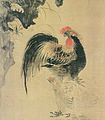This article has multiple issues. Please help improve it or discuss these issues on the talk page. (Learn how and when to remove these messages)
|
| Korean name | |
| Hangul | 장승업 |
|---|---|
| Hanja | 張承業 |
| Revised Romanization | Jang Seungeop |
| McCune–Reischauer | Chang Sŭngŏp |
| Art name | |
| Hangul | 오원 |
| Hanja | 吾園 |
| Revised Romanization | Owon |
| McCune–Reischauer | Owŏn |
| Courtesy name | |
| Hangul | 경유 |
| Hanja | 景猶 |
| Revised Romanization | Gyeongyu |
| McCune–Reischauer | Kyŏngyu |
Jang Seung-eop (Korean: 장승업; 1843–1897), commonly known by his art name Owon, was a Korean painter of the late Joseon period.
He was one of the few painters to hold a position of rank in the Joseon court. His life was dramatized in the award-winning 2002 film Chi-hwa-seon directed by Im Kwon-taek.
Biography
Jang was orphaned at a young age and grew up in poverty. He stayed at the homes of a number of people, including Yi Eung-hŏn (이응헌; 李應憲), Pyŏn Wŏn-kyu (변원규; 卞元圭), and Oh Kyŏng-sŏk [ko], where he was exposed to art.
Together with the earlier painters Danwon and Hyewon, Jang is remembered today as one of the "Three Wons" of Joseon-period painting.
Gallery
-
 Samin munnyeondo
Samin munnyeondo
-
 Hochwido
Hochwido
-
 Painting of a cat by Owon
Painting of a cat by Owon
-
 Sansu inmuldo means "the picture of a man in the landscape"
Sansu inmuldo means "the picture of a man in the landscape"
-
 Rooster
Rooster
-
 Ssangma inmuldo (the painting of a man with two horses)
Ssangma inmuldo (the painting of a man with two horses)
-
 Chowon jirok
Chowon jirok
See also
References
- ^ 강, 영주, "장승업 (張承業)", Encyclopedia of Korean Culture (in Korean), Academy of Korean Studies, retrieved 2024-06-18
This article about a Korean painter is a stub. You can help Misplaced Pages by expanding it. |